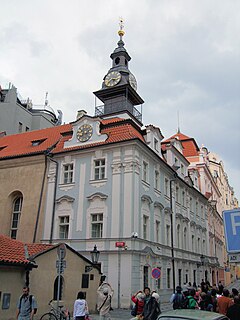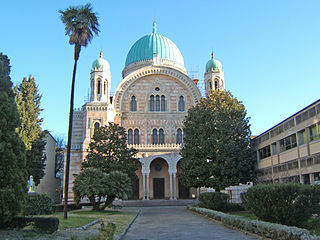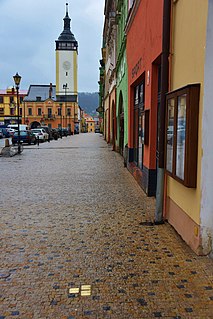
The history of the Jews in Naples deals with the presence of Jews in the city of Naples, Italy. The Jewish presence in the city goes back at least 2,000 years. Today, the Jewish community in Naples numbers around 200 people.[ citation needed ]
| Part of a series on |
| Jews and Judaism |
|---|
 |

The history of the Jews in Naples deals with the presence of Jews in the city of Naples, Italy. The Jewish presence in the city goes back at least 2,000 years. Today, the Jewish community in Naples numbers around 200 people.[ citation needed ]
Records of the first Jews in Naples go back to around the 1st century under the Romans. By 536, the Jewish community of Naples was sufficiently sizeable and economically established to fight with the then-resident Goths against the Byzantines. In 1159, when Benjamin of Tudela visited the city, he noted that 500 Jewish families lived in the city. In 1288, after Dominican priests spread anti-Jewish sentiments, the Kingdom of Naples issued an expulsion order for the Jews and in 1293 any Jews still in Naples were forced to convert. [1]
In 1473, the first Jewish press was established in Naples. In 1492, many Jews who were expelled from Spain came to Naples, where King Ferdinand protected them. However, in 1495, the French conquered the kingdom and persecuted its Jews. In 1510, Spain won control of the city and expelled the Jews, but those who paid 300 ducanti were permitted to stay. In 1535, the price was raised forcing many Jews to leave and by 1541 all Jews of Naples had left.
In 1735, Jews were permitted to return to Naples. In 1831, a small group of Jews settled in the Maltese Cross Hotel where one of the rooms served as a synagogue. In 1841, the Rothschild family, which had set up an office in Naples, acquired the Villa Pignatelli which, according to some accounts, served as the Jewish centre. In 1864, the community rented space in Via Cappella Vecchia, which became the community centre. In 1863, the Rothschild Naples office closed and in 1867 the Villa Pignatelli was sold.
Naples's Jewish community in the 1920s comprised almost 1,000 members. Between 1942 and 1943, 50 Jews of Naples were saved from German deportation by being hidden by villagers in the area of Caserta. Many Jews were taken to extermination camps from Naples and others were killed elsewhere. [2] After World War II, the Jewish community of Naples was made up of only a handful that had survived. Today, the city's Jewish population numbers about 200.

The synagogue in Naples is located on Via Cappella Vecchia. The building, located in the Palazzo Sessa, was inaugurated in 1864 thanks to the influence of Baron Rothschild. In the entrance there are two marble statues; one which remembers the community president Dario Ascarelli who bought the premises for the synagogue in 1910 and the other which commemorates the deportation of Neapolitan Jews during the second world war. The large conference room has been reopened after restoration work that was carried out in 1992. [3]
The history of the Jews in Salzburg, Austria goes back several millennia. Despite being a non-secular province with a Catholic Archbishop as the head of the state, Salzburg has a long record of Jewish history.

The history of the Jews in Prague is one of Central Europe's oldest and most well-known. Prague boasts one of Europe's oldest recorded Jewish communities, first mentioned by an Mizrahi-Jewish traveller Ibrahim ibn Yaqub in 965. Since then, the community never ceased to exist, despite a number of pogroms and expulsions - and the holocaust and subsequent antisemitic persecution by the Communist regime in the 20th Century. Nowadays, the Jewish community of Prague numbers approximately 2,000 members, although the number of Jews in the city is probably as high as 10,000 but for various reasons they remain officially unregistered as such. There are a number of synagogues of all Jewish denominations, a Chabad centre, an old age home, a kindergarten, Lauder Schools, Judaic Studies department at the Charles University, kosher restaurants and even a kosher hotel. Famous Jews from Prague include the Maharal, Franz Kafka, Miloš Forman and Madeleine Albright.

The history of the Jews in Indonesia began with the arrival of early European explorers and settlers, and the first Jews arrived in the 17th century. Most Indonesian Jews arrived from Southern Europe, the United Kingdom, the Netherlands, Belgium, Germany, France, the Middle East, North Africa, India, China, and Latin America. Jews in Indonesia presently form a very small Jewish community of about 100–550, of mostly Sephardi Jews. Judaism is not recognized as one of the country's six official religions, and members of the local Jewish community have to register as Christian or another recognized religion on their official identity cards.
The history of the Jews in Trieste, Italy goes back over 800 years.

The history of the Jews in Luxembourg dates back to the 1200s. There are roughly 1,200 Jews in Luxembourg, and Jews form one of the largest and most important religious and ethnic minority communities in Luxembourg historically.

Sardis Synagogue is a synagogue located in Manisa Province, Turkey. Sardis was under numerous foreign rulers until its incorporation into the Roman Empire in 133 BCE. The city served then as the administrative center of the Roman province of Lydia. Sardis was reconstructed after the catastrophic AD 17 Lydia earthquake, and it enjoyed a long period of prosperity under the Roman rule.

The history of the Jews in Slovenia and areas connected with it goes back to the times of Ancient Rome. The present-day small Jewish community of Slovenia is estimated at 400 to 600 members, with the Jewish community of Slovenia suggesting 500 to 1000 members. Around 130 are officially registered, most of whom live in the capital, Ljubljana.

The history of the Jews in Albania dates back about 2,000 years. According to historian Apostol Kotani : "Jews may have first arrived in Albania as early as 70 C.E. as captives on Roman ships that washed up on the country's southern shores...descendants of these captives that would build the first synagogue in the southern port city of Sarandë in the fifth century...[but] Little is known about the Jewish community in the area until the 15th century."

The Kahal Shalom Synagogue is a Sephardic synagogue in La Juderia, the Jewish quarter of the city of Rhodes on the Greek island of Rhodes. It is the oldest synagogue in Greece today.
The history of the Jews in Turin, Italy, can be first traced to the 4th century when bishop Maximus of Turin recorded the presence of Jews in the city. The city of Turin is in north-west Italy and is the capital of the Piedmont region.
A Jewish population has been in Barbados almost continually since 1654.
The history of the Jews in Munich, Germany, dates back to the beginning of the 13th century. An early written reference to a Jewish presence in Munich is dated 1229, when Abraham de Munichen acted as a witness to the sale of a house in Ratisbon.
The history of the Jews in Sicily deals with Jews and the Jewish community in Sicily which possibly dates back two millennia. Sicily is a large island off the Southern Italian coast. There has been a Jewish presence in Sicily for at least 1400 years and possibly for more than 2000 years.
The history of the Jews in Besançon dates to the Middle Ages, a period during which the Jews settled in the city, attracted by the location of commercial space in the city. The first reference to Jews living there was in 1245.
The History of the Jews in Campania and Basilicata is at least 2000 years old. This area, which is a mix of mountains and rich fertile plains, is south of Rome but north of Calabria and Apulia. Most of the Jewish communities were settled in the Roman Era by Jewish merchants or by Jewish captives after the fall of Jerusalem in the year 70. However, the region was mostly abandoned by the Jews by middle of the 16th century. Today, only the city of Naples has a Jewish population. And, unlike the southern provinces, there seems to be no interest by neofiti descendants to revive the Jewish faith.

The history of the Jews in Florence can be traced over nine hundred years. Florence is the capital city of the Italian region of Tuscany and of the province of Florence. The Jews of Florence have one of the oldest continuous Jewish communities in Europe. The historic Jewish community in Florence is one of the largest and one of the most influential Jewish communities in Italy. The Jewish community in Florence also serves the smaller neighboring Jewish communities in Pisa, Livorno, and Siena.
The history of the Jews in Aruba can be traced back to the 16th century, when the first Jewish immigrants began to arrive. The first Jews in Aruba were Sephardi Jewish immigrants from Netherlands and Portugal. The first Jew to settle in Aruba was a Portuguese-Jewish worker for the Dutch West India Company named Moses Solomon Levie Maduro, who arrived in Aruba with his family in 1754.

The Jewish Museum of Rome is situated in the basement of the Great Synagogue of Rome and offers both information on the Jewish presence in Rome since the second century BCE and a large collection of works of art produced by the Jewish community. A visit to the museum includes a guided tour of the Great Synagogue and of the smaller Spanish Synagogue in the same complex.

The first record of the Jewish community in Bratislava, capital of Slovakia, dates from 1251. Until the end of World War I, Bratislava was a multicultural city with a Hungarian and German majority and a Slovak and Jewish minority. In 1806 when the city was part of the Kingdom of Hungary, Rabbi Moses Sofer established the Pressburg Yeshiva and the city emerged as the center of Central European Jewry and a leading power in the opposition to the Reform movement in Judaism in Europe. Pressburg Yeshiva produced hundreds of future leaders of Austro-Hungarian Jewry who made major influence on the general traditional orthodox and future Charedi Judaism.

The Stolpersteine in Hranice na Moravě lists the Stolpersteine in the town Hranice na Moravě, Czech Republic. Stolpersteine is the German name for stumbling blocks collocated all over Europe by German artist Gunter Demnig. They remember the fate of the Nazi victims being murdered, deported, exiled or driven to suicide.